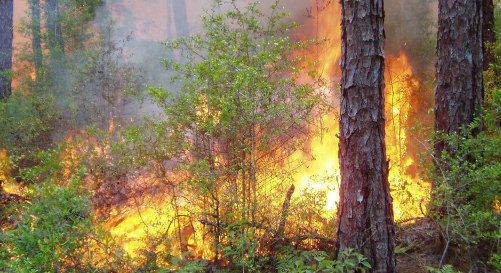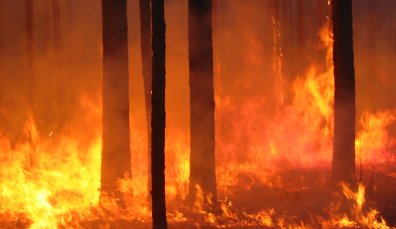
Different sorts of fires are prescribed for different purposes. The variations usually depend on the wind direction and topography. A backing fire goes against the wind and spreads slowly by conduction. It is the safest fire and consumes most of the fuel, but it is slow. A head fire goes in the direction of the wind and/or uphill. Flames are carried by the wind, so things burn faster, but it tends to be a less complete burn. The fire jumps over some fuel. That jumping also makes this fire more likely to get out of hand. Other variations are flanking fires, as the name implies along the sides and strip fires. The strip fire is a series of head and back fires. They run into each other. The strip fire is faster than other fires because you light several places at a time. Similar to a strip fire is a spot fire, where you light a series of spots that come together. The spot fires work well in theory, but they very often turn into strip fires anyway, just because it is hard to keep the spots apart. The challenge with all multiple fires is when they come together. They rise up and can scorch the trees or even provoke a crown fire.

The time of the year when you set your fires depends on your management goals. A dormant/winter season fire will consume the surface vegetation but won’t usually kill it. In fact it will create a lot more sprouts and shoots, especially with understory hardwoods and blueberries. This kind of fire produces a lot of good browse for deer, but it will not yield the herbaceous growth for other species. A growing season burn will often kill much of the woody vegetation and over time it will produce the savannah-like open forests with a herbaceous forest floor. It produces more flowering, legumes and releases nutrients to the soil. If a forest has not been burned for a long time, a winter backing fire is probably smarter. It cleans up the debris at a cooler temperature that is less likely to damage your trees. After that you can do the growing season fire as appropriate. May/June is a good time.
In a loblolly rotation, it makes sense to wait a year after thinning and then do a winter season fire to clean up the slash. After that, go with a spring time burn every 2-3 years.
Loblolly pines usually survive scorching. The biggest danger to them is in October, after they have finished growing for the year, but before they have gone dormant. A scorching will probably kill them at this time, so you should never burn in October. The State of Virginia bans outdoor burning until after 4pm from February to April. This is the time when conditions are dry and the leaves are off the trees. There is significant danger of fire escaping.
A major concern in fire management is its effect on the soils. An intense fire burns hot. A severe fire burns down more of the soil. Sometimes you want to expose mineral soil since some plant communities require that to regenerate; most of the time you don’t. Usually it is best when you see black. The vegetation has been carbonized but much is still intact. White is ash. Too much white means you burned a little too severe. It is bad when orange is exposed. If the soil gets burned bad enough, it can become impervious to water. The fast run off caused by the impervious soils can create mud slides.
Burning off too much soil litter can lead to erosion in general. Summer rains in Virginia can be torrential. The water hits hard and washes the soil downhill. All land erodes. An intact forest in Virginia loses from .05-.1 ton of soil per year on average. By contrast, field crops can lose 3-15 tons a year. After a burn, a forest floor loses more than the intact forest, but less than plowed field, depending on how severe the burning was. But repeated small burns create a stabile herbaceous layer that helps build a healthy soil that mitigates erosion in the longer run. Good forest stewardship means thinking in the long term. Be aware of how what you are doing now will be in years or decades.
Of course, erosion is an eternal process that never stops. The Appalachians were once as high as the Rockies and in the future the Rockies will be as low as the Appalachians. Erosion & time will flatten Mt Everest. Everything washes down and everything has to go somewhere. If a ton of soil flows from one acre to the one down hill and that one loses a ton of soil to the one below that, it is really not much of a problem. Each acre “loses” a ton of soil, but not really. It becomes a problem when too much soil is lost and when it flows into watercourses. The water from my farms flows eventually into Albermarle Sound via the Meherrin and Chowan rivers. An important duty is to protect the waterways from too much silt. That is why we don’t cut near the streams (stream management zones) and generally tred lightly near them. Beyond that, you just don’t want to lose your dirt, on which all prosperity depends.
